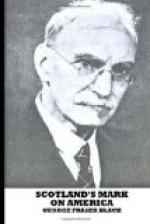under water at a speed of over seventy miles an hour,
and he has made important experiments in the field
of aeronautics and in other arts and sciences.
The mother of Thomas Alva Edison (b. 1847), it may
here be mentioned, was of Scottish parentage (Elliott).
The originator of the duplex system in the manufacture
of railroad tickets was William Harrison Campbell
(1846-1906), of Scottish parentage. William Malcolm
(1823-90), also of Scottish parentage, was the inventor
of telescopic sights, an invention adopted by all
civilized governments. His attainments were better
known and appreciated in Europe than in his own country.
Daniel McFarlan Moore, electrician and inventor, of
Ulster Scot descent, was inventor of the Moore electric
light. James Peckover, born in England of Scottish
and English ancestry, invented the saw for cutting
stone and a machine for cutting mouldings in marble
and granite. Rear-Admiral George W. Baird (b.
1843), naval engineer, invented the distiller for
making fresh water from sea water, and patented many
other inventions in connection with machinery and
ship ventilation. James Bennett Forsyth (b. 1850),
of Scottish parentage, took out more than fifty patents
on machinery and manufacturing processes connected
with rubber and fire-hose. John Charles Barclay,
telegraph manager, descendant of John Barclay who
emigrated from Scotland in 1684, patented the printing
telegraph “said to be the most important invention
in the telegraph world since Edison introduced the
quadruplex system.” Alexander Winton, born
in Grangemouth in 1860, inventor and manufacturer,
successfully developed a number of improvements in
steam engines for ocean going vessels, founded the
Winton Motor Carriage Company in 1897, and patented
a number of inventions in connection with automobile
mechanism. The works of the company at Cleveland,
Ohio, now cover more than thirteen acres. The
first to expound and formulate the application of the
law of conservation in illumination calculations was
Addams Stratton McAllister (b. 1875), a descendant
of Hugh McAllister, who emigrated from Scotland c.
1732. He also holds several patents for alternating-current
machinery, and has written largely on electrical subjects.
Richard Dudgeon (1820-99), born in Haddingtonshire,
Scotland, was distinguished as a machinist, inventor
of the hydraulic jack and boiler-tube expander.
SCOTS AS ENGINEERS
Thomas Hutchins (1730-1789), engineer and geographer was of Scottish origin. He was author of some topographical works and also furnished the maps and plates of Smith’s Account of Bouquet’s expedition (Philadelphia, 1765). James Geddes (1763-1838), of Scottish birth or parentage, was surveyor of canal routes in New York State and was chief engineer on construction of the Erie Canal (1816), and chief engineer of the Champlain Canal (1818). “In all matters relating to the laying out, designing and construction of canals, he was looked upon as




